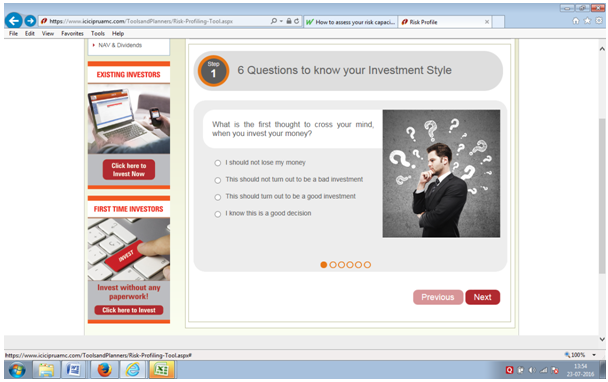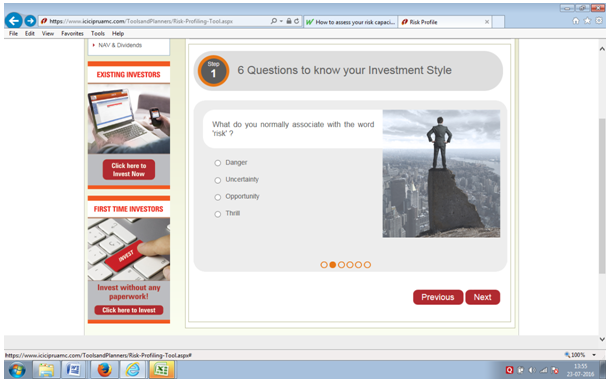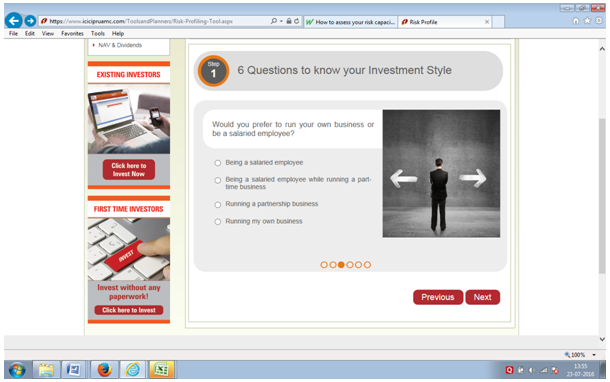Are you risk averse: Understand your risk capacity

Are you risk averse or do you like taking risks? The answer to this question is often determined by your personality. Some people, by nature, want to play safe; they do not want to lose their sleep over the prospect of losing money. These people are risk averse. Others are aggressive, more motivated by prospect of making money rather than the risk of losing it. They are the risk takers. In behavioural terms, two emotions, fear and greed, determine our risk taking behaviour. Risk taking behaviour of an individual may change over time. For example, in bear markets risk aversion is seen to increase whereas in bull markets risk taking increases. Risk appetite can also change with change in personal situations. Willingness to take risk is known as risk appetite. However, willingness to take risks may or may not be correlated with the person’s ability to take risks. For example, a 25 year old young professional with good income and no liabilities may have low risk appetite, even though his ability of taking risks should be high. The ability to take risks is known as the risk capacity of an individual.
We should be very clear about the distinction between risk appetite and risk capacity. Your investment decisions should ideally be guided by your risk capacity and not your risk appetite, but we often see that, it is the other way around. Risk return relationship is one of the fundamental laws of finance. You cannot get higher returns unless you take more risks. The investor with low risk appetite and high risk capacity needs to understand, that he or she may be compromising on their long term financial future; on the other hand, an investor with high risk appetite and low risk capacity needs to understand the potential implications on financial safety. In this post we will discuss how investors can measure their risk capacities and put it to practical applications in their investment decisions. We will discuss several methods to determine risk capacities of investors. It is important to note that, none of these methods on a standalone basis is a comprehensive measure of risk tolerance. You should use a combination of two or more of these methods, depending upon the situation, to gain a comprehensive understanding of your risk capacity. Here are some commonly used measures of risk capacity.
Asset Allocation Rule of 100
This is a very popular asset allocation heuristic for measuring risk tolerance. Simply put, you should subtract the investor’s age from 100, and the result suggests the maximum percentage amount of the investor’s portfolio that should be exposed to equities. So for a 25 year old investor, this rule suggests that 75% of his or her portfolio should be invested in equities, and for a 40 year old investor, this rule suggests that 60% of the portfolio should be invested in equities. You should understand that, heuristics, also sometimes known as thumb rules, are practical methods, not guaranteed to be perfect or optimal, but on an average, gives sufficiently good results. One criticism of this method is that, since average life spans are increasing, this rule does not give sufficient equity allocations to retirees and therefore may fall short of meeting the cash flow needs of the retirees through their lifetimes, especially in high interest regimes. Some financial planners believe that these days, Rule of 120 is more effective.
Maximum Loss Rule
The Max Loss formula seeks to help investors determine the maximum percent of their portfolio that they should expose to equities. Max Loss depends on two factors:-
- What is the maximum percentage of your portfolio that you can tolerate losing in one year?
- What is the maximum percentage that you think the stock market can lose in one year?
The formula of Max Loss % is as follows:

Let us illustrate this with an example. Let us assume, you can afford to lose a maximum 5% of your portfolio value in a year and the maximum possible drop in the market in 1 year is 30%. The maximum percentage of portfolio loss should not be an ad-hoc or whimsical number. You should factor in your monthly cash-flows, your short term and long term liability situation and your average liquidity positions in determining the maximum loss that you can tolerate.
In other words, if for some reason, you had to redeem your portfolio what is the maximum loss you can afford to bear. The maximum market loss should be based on how much the market fell on an average in bear markets. A bear market is usually defined as the period, when the market fell by more than 20% from its high. Remember that, this is simply your expectation of maximum market fall percentage. One can never forecast how much the market will fall in a bear market. Let us further assume that you can get a risk free return of 8%. The Max Loss % will be (5% + 8%) divided by (30% + 8%). When we do the math, we can a Max Loss % of 34%. This should be equity allocation in your overall investment portfolio.
Investment Time Horizon
This is one of the most important factors in determining risk tolerance. The longer is the investor’s time horizon greater is his or her risk capacities. Investors should look at their investment goals and determine the time horizon for accomplishment of these goals. Longer your investment time horizon, higher is your risk capacity. This is because, volatility is a bigger risk in the short term than in the long term (please see our post, How Investing in Equities for the long term reduces risk). While there are no hard-and-fast rules, following are some general guidelines that can investors decide which investments types are suitable for various investment tenures.
Short term:
Generally, short term horizon is less than 5 years (in India sometimes short term horizon is taken to be less than 3 years). Fixed income is the most appropriate asset class in the short term. Short term can further be sub-divided in different investment tenures. Debt mutual funds offer good solutions for variety of short term investment needs (please see our blog post, Demystifying debt mutual funds).Medium Term:
Generally, medium term is 5 to 10 years. Your risk capacity is higher in medium term and therefore you should have some exposure to equities, to get higher portfolio returns and meet your investment goals. Hybrid investment approach is usually advised in the medium term. Balanced mutual funds can be excellent medium term investment choices.Long Term:
Long term is more than 10 years. Your risk capacity is the highest. A long time horizon allows your investments to recover from temporary losses and create wealth for you through the power of compounding. Equity is the best asset class for long investment tenures. Gold is also a suitable asset class for investment tenures. In our blog, Equity is the best performing asset class in long term: Myth or Truth, we discussed relative performances of different asset classes in the long term. Within equity as an asset class, based on your risk appetite, you can also take some exposure to small and midcap stocks (through small and midcap equity mutual funds) if you have long term investment horizon.
Psychometric Risk Profiling
Many investment portals use psychometric risk questionnaires to profile an investor’s risk capacity. Investors are asked to answer a set of multiple questions and the answers to the questions help in evaluation of the investor’s risk tolerance. Please see below, some screen shots of ICICI Prudential Mutual Fund’s Risk Profiling tool.

A properly designed questionnaire such as the one above enables a psychometric evaluation of the investor’s risk tolerance.


In our opinion, while a well designed risk profiling tool can give you useful information about your risk capacity, you should use this in combination the other methods discussed above.
Conclusion
While the above methods can give useful information about your risk capacity, which you can put to practical use in your investment decisions, a comprehensive understanding of your risk capacity, will require an evaluation of your financial situation. This will include evaluation of cash flows (income, expenses and investments), your asset profile (liquid, fixed income, equity etc), your short term and long term liabilities (debt) etc. It will also be useful to have a discussion on your risk capacity versus risk appetite with your financial planner or financial advisor.
Mutual Fund Investments are subject to market risk, read all scheme related documents carefully.
RECOMMENDED READS
LATEST ARTICLES
- Why you need to have hybrid mutual funds in your portfolio: Different types of funds Part 2
- Why you need to have hybrid mutual funds in your portfolio: Misconceptions Part 1
- Which is the best time to invest in mutual funds
- Economic slowdown: Is it real and what should you do
- Importance of liquidity in investing: Mutual funds are ideal solutions
An Investor Education Initiative by ICICI Prudential Mutual Fund to help you make informed investment decisions.
Quick Links
Follow ICICI Pru MF
More About ICICI Pru MF
POST A QUERY




